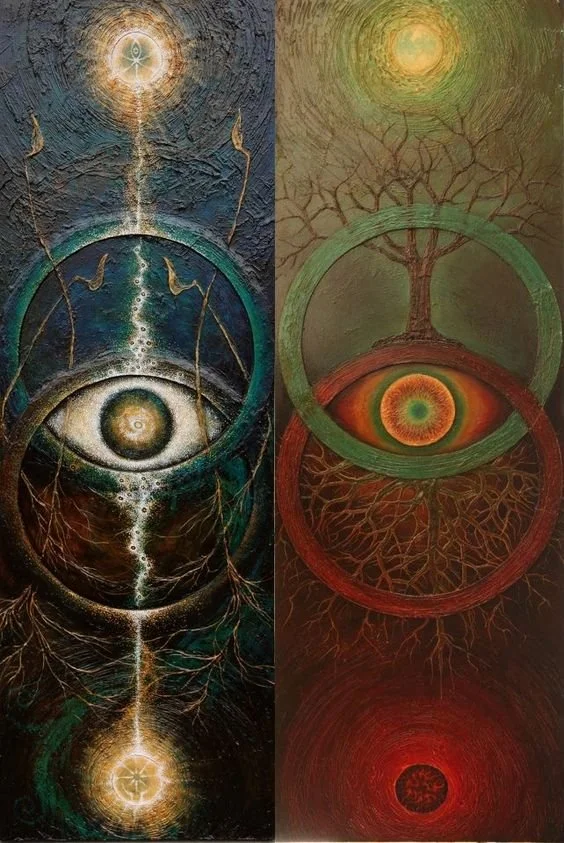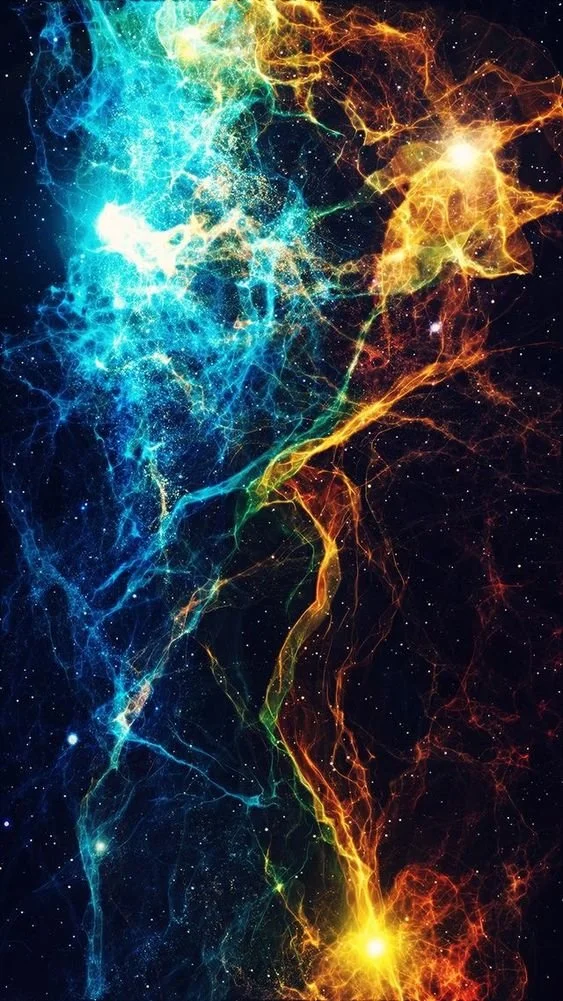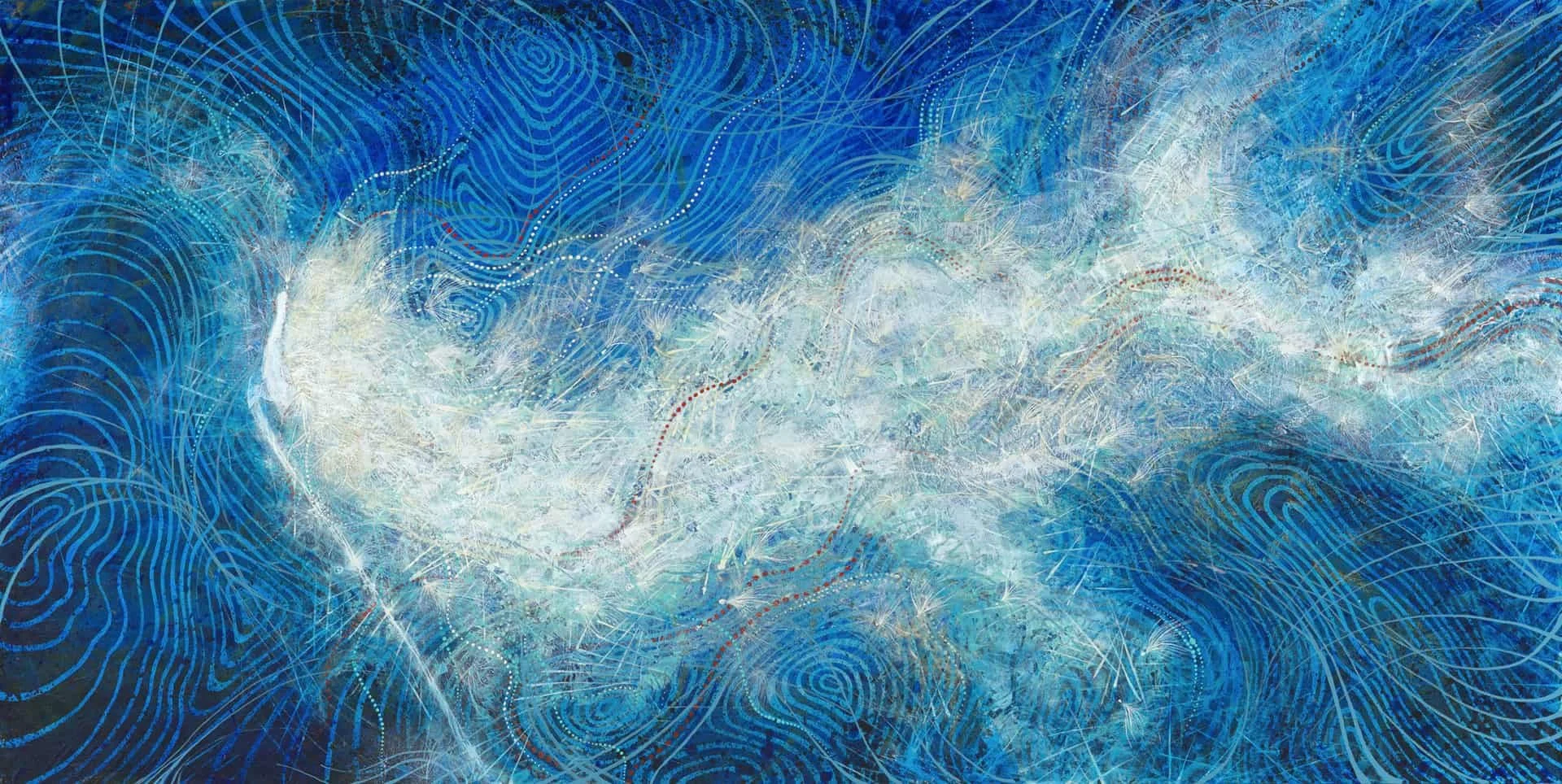Beyond Balance: Discharging Static Community
Interplay as Evolving Process
Practicing Community – Part Eighteen
“Above and Below” by Martin and Carl Bridge
It is the nature of community to gravitate toward states of equilibrium. To move toward harmony and cohesion, which is necessary for the health and survival of the group. This is especially important early in the forming of a community, strengthening the bonds that bring us together to coalesce into form.
Once a community has gotten going and foundational security is established, norms start to solidify. A natural balancing out occurs as the collective energy of the group seeks stability. After all the energy of coming together and risk associated with opening up beyond our individualism, we often seek to rest and conserve. In a less healthy sense, this can look like an attempt to freeze things in place, codifying and establishing set norms—seeking static equilibrium. Or it can look like a constant balancing act, seeking dynamic equilibrium through trying to manage countering forces.
The thing about equilibrium is that it leaves a total sum energy of zero. Everything is canceled out. There is nothing left to give off and share. It may seem more comfortable (though often the energy exerted to maintain equilibrium is just as taxing), but it isn’t generative.
Deeply embedded into our biology is the instinct that community is about survival. Safety in numbers. It is rooted into our natural drive to come together with others for protection and security. As such, the best thing to do was to strengthen the bonds of the group and maintain collective order—even expelling overly divisive and diverse members that would upset the stability of the community. Our very existence may have depended on it.
Might there actually be a similar movement happening today, necessary for our survival, but in a different way? Moving toward the collective, recognizing that we deeply need each other again in order to survive. That the myth of individual independence is crumbling in a way we feel deep in our bones.
But going forward, our survival will be less dependent on sameness and conformity to the collective for the sake of group stability. Rather, we will find our path through by welcoming the interplay of our unique diversity growing the field of possibility exponentially, dancing together in the multiplicity of energies where emergence comes forth.
“Dancing Energies” – artist unknown
Welcoming Interplay in Community
In the last article, we looked at values of mystical community, which are some of the core energies of how we interact and engage in healthy community. These are fixed principles that represent a certain way of being is better than another. It is better to be receptive than closed off, generous than stingy, trusting than suspicious, and so on.
Alongside preferential values, there are always a few dynamics that are constantly operating in the midst of any community—polarities of energies that are in regular interaction with or against one another. These aspects are inherent in the nature of community. And rather than over-emphasizing one pole, community will be the healthiest when we are living within the dynamic interplay of these elements.
They interact in a way that can easily lead to strain in community. There is often tension underlying the relationship of these polarities. This can lead to a lot of stress, especially if both ends are holding tight. If held loosely, they can operate in a more playful exchange.
An example might be helpful now—for instance, there is a dynamic interplay between privacy and openness in community. Neither one by itself is necessarily preferred and held over the other (like a value). If we go too far in either direction, it will cost the health of ourselves or others. Some privacy is always necessary, creating necessary enclosures that foster intimacy. As is a good degree of openness—without over-exposing or sharing more than is fitting.
We’ll look at several of these key interplays that are especially primary in spiritual community and how we can learn to dance with them. We should not seek to have one end of the pole “defeat” the other. Nor do we seek an exact, fixed point of balance between the two. It is the pushing and pulling that keeps us from settling too comfortably into one or the other. And this is to our benefit, even if it doesn’t feel that way in the struggle that can come from the “competing” forces.
Rather, we can learn to flow with the movements of collective life, sensing and intuiting in the moment what is happening in our midst. To do this, we need to stay flexible, constantly adapting with the ever-changing nature of life together. We get into trouble when we get locked into one side. It’s best when we can hold these with freedom and playfulness, seeking how we might integrate and complement the two dynamics together for the good of the whole.
We looked at one of these earlier in this series in how a community holds being and doing, identity and purpose. Now let’s consider a few more.
Unity & Multiplicity
This might be the most fundamental interplay in community. How do we hold the needs and experiences of individuals with the needs of the larger collective whole?
The word “Com-Unity” means unity together, which is a bit of a paradoxical statement. This interplay is built right into the fabric of the nature of community.
If we are in union, we might assume we are joined without differentiation. In spiritual and more mystical communities, this is often even more highlighted with the emphasis on oneness. No need to worry about difference. If we’re all one, man, just chill out and dwell in the bliss!
While this may be the case in certain spiritual states, for the most part, we are all still living in the unique particularity as individuals—even in union.
Other types of communities interact with this as well, leading to groupthink or herd mentality when particularity has been deemphasized too much. Or on the other end, when singular agendas derail community because they’re not responsive to the whole.
In ICN, we wanted to honor this interplay in our fundamental values, naming both “Uniqueness” and “We” as essential to mystical community.
We talk a lot about moving beyond individualism in our spiritual lives and practice—which is one end of the pole that tends to be predominant in Western culture these days. On the other side is codependency, where we cling and grasp onto the other for a sense of security and safety.
This is the dynamic interplay. We are not islands of self, nor are we undifferentiated parts of a larger whole.
Healthy individuality fosters healthy community, where both the “I” and the “We” matter. The particular and the whole. Unity and multiplicity.
Even in our interbeing, we dance between connecting and experiencing beyond the limitations of our singular self, while also inhabiting and incarnating in our distinctive gifts and particular expressions in life.
“Wave & Particle” – art by variandigital
Settling & Moving Forward
Another common interplay in community is the dynamic of moving forward or settling in. To continue to evolve or to stay with what is working. This is the tension between striving and accepting. Being where we are with contentment while also continuing to grow.
This may or may not be about growth in numbers—as our culture of growth assumes that more is always better. “If you’re not growing, you’re dying,” as the business adage says. But growth can take shape in many forms. And periods of growth often need to be followed by times of integration.
If we’re constantly adding on, assembling and gathering more and more, we lean into the hoarder’s mentality. In community, this can look like always wanting there to be more people, feeling that the worth of the group is based on bigger numbers. It can also look like moving from one thing to the next, feeling bored by repetition and stimulated by novelty.
On the other end, there can be a tendency to rest on our laurels, to be fine with how things are. “If it ain’t broke, don’t fix it,” the proverb recommends. In community, we might fear change because we like the way things are. We don’t want to lose what we have. And while there are times for staying with what is, without movement of some kind, things will become stale and stuck in the doldrums.
Spiritual communities most often tend toward the side of settling in. We even often connote “religion” with a sense of immobile institutionalism. Tradition is valued more highly than innovation. Going forward, our spiritual gatherings will more and more need to take on the task of navigating a vastly changing world—meeting it not just with the tried and true, which may or may not still be true given new context. But also pioneering into the needed new, with the resource of being deeply connected to Source, which will bring forth the divine emergence for what is necessary in the days ahead.
“On the Wind” by Martin Bridge
Ideas & Experiences
When people gather together in community, there is the time, the place, and the third thing. This “third thing” is what the group is gathered around. In a sense, it is what gets placed in the center of the circle (or up front on the stage). It is the focus of the time together.
In many community settings, the third thing is the content. That which is being learned together. The study of a text. The topic of a sermon. The new information brought forth in one form or another. We humans love to learn—and we learn more about this “thing” and discuss it together. However, in this day and age where “content is king,” this end of the pole often gets overweighted.
In other types of community, the third thing is more of an activity, a shared experience. The group meets because they are a pickleball club. They play pickleball together. People are learning how to play better, and there might be some minor instruction at times, but that is not the purpose or intent of the time together. It’s to play.
In spiritual community, both are usually present in some form. Such as the activity of worship and the content of a sermon. The bible study and the volunteer service. Some folks tend to gravitate more toward one or the other in preference, but the opportunity for integrating both will be present in a healthy community structure.
At times in deepening community, the third thing becomes less essential or necessary. Or, to put it another way, the third thing arises and comes alive in the moment through the deep presence and mutual attunement of the people themselves. There usually is still a process to aid in coming to this, but the process itself isn’t the third thing (it’s not the focus). Rather, it is the collective field of the community itself that generates the in-the-moment, co-created focus.
This is the movement from needing to do something together to simply dwelling in the aliveness of being together. This comes through inhabiting what we’ve learned and integrating what we’ve experienced before. And from this place, further action or avenues of inquiry for learning arise.
We have found that this comes about through emphasis on sharing spiritual experience and being together in the mystical consciousness of divine presence in, around, and through one another. To be a mystical community is to embody the deep interconnections that exist among us, not solely defined by shared ideas or shared experiences, but perhaps by the interplay of these in our midst and what arises in spirit consciousness in the present moment.
It is through our embodied centers of knowing and being that we can integrate these interplays, welcoming all of our structures of consciousness. Welcoming the mental and its craving for content and ideas while also dwelling in the heart of love and connective energy. Present with our feet and bodies in action and interbeing while welcoming intuitive and source oneness.
This is not a definitive list of all interplays and dynamic tensions in community, but rather an offering of some of the most common. Are there others you would add that you’ve experienced?
Practicing Dynamic Community
Balance is not the goal of community. States of equilibrium help bring about stability, yes. But then we must not become too oriented around “maintaining the peace.” Rather, can we come to welcome the pulls and tensions of these interplays in community?
We need to discharge static community, recognizing that it will not serve us in the evolving journey ahead. It is most often stress, not comfort, that drives evolution. But that doesn’t mean that it has to be a painful strain.
A stringed instrument tuned just right can play beautiful music. If it is stretched too tight, there will be discordant tension and an eventual snap and breaking. If it is too loose, the sound comes out dull or not at all.
Can we learn to practice interplay in community, recognizing that they are essential to creating dynamism, growth, and evolution?
Can we embrace the “play” in interplay, dancing with the seeming contradictions without the fearful need to always resolve them for the sake of order?
Can we play beautiful music together in harmonic resonance, not all playing the same notes but finding the symphonic beauty in our concerted, collective chorus?
And when many musicians play together, they will play best if they have a good conductor. Leadership in community is a dynamic interplay in its own right, which will be the topic of next week’s article.
“Balance and Flow” – photograph by Reidel Meier
Practicing Community:
Practice interplay in a playful way. Approach a situation in your community that is existing in dynamic tension with an attitude of curiosity and fun, being willing to experiment and try out new things.
How are you navigating the dynamics of the tensions of participating in community? Do you feel like there are areas that need counterbalancing or integration? Reflect and then set an intention to respond with action as you are being led.





